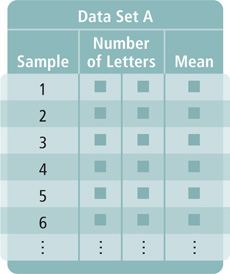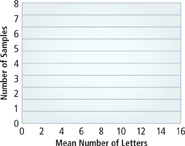Concept Byte: Describing Data
For Use with Lesson 11-7
ACTIVITY
Suppose you want to know the mean number of letters in the last names of everyone listed in your local phone book. You could count the letters in every last name, but that is not very practical. Instead, you could approximate this mean by taking a sample of last names and finding the mean number of letters in only those names.


Activity 1
| Step 1 | Copy the table above. Extend the table to go to Sample 20. |
|---|---|
| Step 2 | Without looking, open a phone book to a random page. Place your index finger on the page, still without looking. Then, count the number of letters in the name closest to the tip of your finger. Record this number in the table in the first blank space for Sample 1. Close the phone book. |
| Step 3 | Repeat Step 2 and record this number in the table in the second blank space for Sample 1. These two numbers make up one sample. Find the mean and record it in the table. |
| Step 4 | Collect a total of 20 samples by repeating Steps 2 and 3. |
| Step 5 | Copy the grid above and use the means from Data Set A to make a bar graph. |
| Step 6 | Make a second table with space for 10 numbers in each of the 20 samples. Label this table Data Set B. |
| Step 7 | Repeat Steps 2 and 3, but now select 10 names for each sample. Record the data in the second table. |
| Step 8 | Copy the grid again and use the means in Data Set B to make a bar graph. |
- Does the graph of Data Set A or the graph of Data Set B show more variation?
- Which data set has a greater range?
- Which data set has a greater standard deviation?
- The Law of Large Numbers states that the variation in the means of repeated samples decreases as the sample size increases. Do your results support this law?
- Compare and Contrast Compare your results with those of another student in the class. How are they the same? How are they different?
- Reasoning Suppose you conduct this experiment by collecting all of the samples from one page of the phone book. Predict how this sampling technique might affect your results.
Table of Contents
Prentice Hall Algebra 2
Selected Answers
Index
Acknowledgments
Contents in Brief
Series Authors
Consulting Authors
Program Authors
Reviewers National
From the Authors
Power Algebra.com
Big Ideas
Exploring Concepts
Thinking Mathematically
Active Learning
Practice Makes Perfect
Pearson Video Challenge
Acing the Test
BIG ideas
Entry-Level Assessment
Chapter 1 Expressions, Equations, and Inequalities
Get Ready!
1-1 Patterns and Expressions
1-2 Properties of Real Numbers
1-3 Algebraic Expressions
1 Mid-Chapter Quiz
1-4 Solving Equations
1-5 Solving Inequalities
1-6 Absolute Value Equations and Inequalities
1 Pull It All Together
1 Chapter Review
1 Chapter Test
1 Cumulative Test Prep
Chapter 2 Functions, Equations, and Graphs
Get Ready!
2-1 Relations and Functions
2-2 Direct Variation
2-3 Linear Functions and Slope-Intercept Form
2-4 More About Linear Equations
2 Mid-Chapter Quiz
Concept Byte: Piecewise Functions
2-5 Using Linear Models
2-6 Families of Functions
2-7 Absolute Value Functions and Graphs
2-8 Two-Variable Inequalities
2 Pull It All Together
2 Chapter Review
2 Chapter Test
2 Cumulative Test Prep
Chapter 3 Linear Systems
Get Ready!
3-1 Solving Systems Using Tables and Graphs
3-2 Solving Systems Algebraically
3-3 Systems of Inequalities
3 Mid-Chapter Quiz
3-4 Linear Programming
Concept Byte: Linear Programming
Concept Byte: Graphs in Three Dimensions
3-5 Systems With Three Variables
3-6 Solving Systems Using Matrices
3 Pull It All Together
3 Chapter Review
3 Chapter Test
3 Cumulative Test Prep
Chapter 4 Quadratic Functions and Equations
Get Ready!
4-1 Quadratic Functions and Transformations
4-2 Standard Form of a Quadratic Function
4-3 Modeling With Quadratic Functions
Concept Byte: Identifying Quadratic Data
4-4 Factoring Quadratic Expressions
4 Mid-Chapter Quiz
Algebra Review: Square Roots and Radicals
4-5 Quadratic Equations
Concept Byte: Writing Equations From Roots
4-6 Completing the Square
4-7 The Quadratic Formula
4-8 Complex Numbers
Concept Byte: Quadratic Inequalities
4-9 Quadratic Systems
Concept Byte: Powers of Complex Numbers
4 Pull It All Together
4 Chapter Review
4 Chapter Test
4 Cumulative Test Prep
Chapter 5 Polynomials and Polynomial Functions
Get Ready!
5-1 Polynomial Functions
5-2 Polynomials, Linear Factors, and Zeros
5-3 Solving Polynomial Equations
5-4 Dividing Polynomials
5 Mid-Chapter Quiz
5-5 Theorems About Roots of Polynomial Equations
Concept Byte: Solving Polynomial Inequalities
5-6 The Fundamental Theorem of Algebra
Concept Byte: Pascal's Triangle
5-7 The Binomial Theorem
5-8 Polynomial Models in the Real World
5-9 Transforming Polynomial Functions
5 Pull It All Together
5 Chapter Review
5 Chapter Test
5 Cumulative Test Prep
Chapter 6 Radical Functions and Rational Exponents
- 5-1 Polynomial Functions
- 5-2 Polynomials, Linear Factors, and Zeros
- 5-3 Solving Polynomial Equations
- 5-4 Dividing Polynomials
- 5-5 Theorems About Roots of Polynomial Equations
- 5-6 The Fundamental Theorem of Algebra
- 5-7 The Binomial Theorem
- 5-8 Polynomial Models in the Real World
- 5-9 Transforming Polynomial Functions
Get Ready!
Concept Byte: Properties of Exponents
6-1 Roots and Radical Expressions
6-2 Multiplying and Dividing Radical Expressions
6-3 Binomial Radical Expressions
6-4 Rational Exponents
6 Mid-Chapter Quiz
6-5 Solving Square Root and Other Radical Equations
6-6 Function Operations
6-7 Inverse Relations and Functions
Concept Byte: Graphing Inverses
6-8 Graphing Radical Functions
6 Pull It All Together
6 Chapter Review
6 Chapter Test
6 Cumulative Test Prep
Chapter 7 Exponential and Logarithmic Functions
Get Ready!
7-1 Exploring Exponential Models
7-2 Properties of Exponential Functions
7-3 Logarithmic Functions as Inverses
Concept Byte: Fitting Curves to Data
7 Mid-Chapter Quiz
7-4 Properties of Logarithms
7-5 Exponential and Logarithmic Equations
Concept Byte: Using Logarithms for Exponential Models
7-6 Natural Logarithms
Concept Byte: Exponential and Logarithmic Inequalities
7 Pull It All Together
7 Chapter Review
7 Chapter Test
7 Cumulative Test Prep
Chapter 8 Rational Functions
Get Ready!
8-1 Inverse Variation
Concept Byte: Graphing Rational Functions
8-2 The Reciprocal Function Family
8-3 Rational Functions and Their Graphs
Concept Byte: Oblique Asymptotes
8 Mid-Chapter Quiz
8-4 Rational Expressions
8-5 Adding and Subtracting Rational Expressions
8-6 Solving Rational Equations
Concept Byte: Systems With Rational Equations
Concept Byte: Rational Inequalities
8 Pull It All Together
8 Chapter Review
8 Chapter Test
8 Cumulative Test Prep
Chapter 9 Sequences and Series
Get Ready!
9-1 Mathematical Patterns
9-2 Arithmetic Sequences
Concept Byte: The Fibonacci Sequence
9 Mid-Chapter Quiz
9-3 Geometric Sequences
9-4 Arithmetic Series
Concept Byte: Geometry and Infinite Series
9-5 Geometric Series
9 Pull It All Together
9 Chapter Review
9 Chapter Test
9 Cumulative Test Prep
Chapter 10 Quadratic Relations and Conic Sections
Get Ready!
10-1 Exploring Conic Sections
Concept Byte: Graphing Conic Sections
10-2 Parabolas
10-3 Circles
10 Mid-Chapter Quiz
10-4 Ellipses
10-5 Hyperbolas
10-6 Translating Conic Sections
Concept Byte: Solving Quadratic Systems
10 Pull It All Together
10 Chapter Review
10 Chapter Test
10 Cumulative Test Prep
Chapter 11 Probability and Statistics
Get Ready!
11-1 Permutations and Combinations
11-2 Probability
11-3 Probability of Multiple Events
Concept Byte: Probability Distributions
11-4 Conditional Probability
11 Mid-Chapter Quiz
11-5 Analyzing Data
11-6 Standard Deviation
11-7 Samples and Surveys
Concept Byte: Describing Data
11-8 Binomial Distributions
11-9 Normal Distributions
Concept Byte: Approximating a Binomial Distribution
11 Pull It All Together
11 Chapter Review
11 Chapter Test
11 Cumulative Test Prep
Chapter 12 Matrices
Get Ready!
12-1 Adding and Subtracting Matrices
Concept Byte: Working with Matrices
12-2 Matrix Multiplication
Concept Byte: Networks
12-3 Determinants and Inverses
12 Mid-Chapter Quiz
12-4 Inverse Matrices and Systems
12-5 Geometric Transformations
12-6 Vectors
12 Pull It All Together
12 Chapter Review
12 Chapter Test
12 Cumulative Test Prep
Chapter 13 Periodic Functions and Trigonometry
Get Ready!
13-1 Exploring Periodic Data
Geometry Review: Special Right Triangles
13-2 Angles and the Unit Circle
Concept Byte: Measuring Radians
13-3 Radian Measure
13-4 The Sine Function
13 Mid-Chapter Quiz
Concept Byte: Graphing Trigonometric Functions
13-5 The Cosine Function
13-6 The Tangent Function
13-7 Translating Sine and Cosine Functions
13-8 Reciprocal Trigonometric Functions
13 Pull It All Together
13 Chapter Review
13 Chapter Test
13 Cumulative Test Prep
Chapter 14 Trigonometric Identities and Equations
Get Ready!
14-1 Trigonometric Identities
14-2 Solving Trigonometric Equations Using Inverses
14-3 Right Triangles and Trigonometric Ratios
14 Mid-Chapter Quiz
14-4 Area and the Law of Sines
Concept Byte: The Ambiguous Case
14-5 The Law of Cosines
14-6 Angle Identities
14-7 Double-Angle and Half-Angle Identities
14 Pull It All Together
14 Chapter Review
14 Chapter Test
End-of-Course Assessment to Prepare for the ADP Algebra 2 Test
Skills Handbook
Percents and Percent Applications
Operations With Fractions
Ratios and Proportions
Simplifying Expressions With Integers
Area and Volume
The Coordinate Plane, Slope, and Midpoint
Operations With Exponents
Factoring and Operations With Polynomials
Scientific Notation and Significant Digits
The Pythagorean Theorem and the Distance Formula
Bar and Circle Graphs
Descriptive Statistics and Histograms
Operations With Rational Expressions
Reference
Properties and Formulas
Formulas of Geometry
English/Spanish Illustrated Glossary




